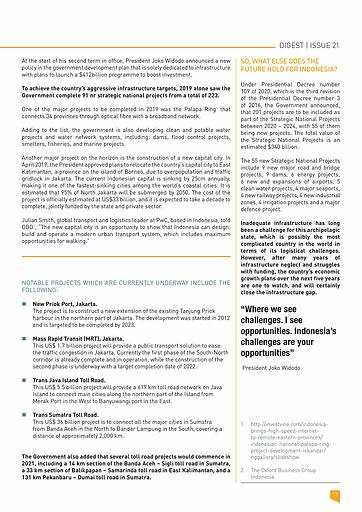Driver Trett Digest Issue 21 03.2021 - Flipbook - Page 12

DIGEST | ISSUE 21
At the start of his second term in office, President Joko Widodo announced a new
policy in the government development plan that is solely dedicated to infrastructure
with plans to launch a $412billion programme to boost investment.
Adding to the list, the government is also developing clean and potable water
projects and water network systems, including: dams, flood control projects,
smelters, fisheries, and marine projects.
Under Presidential Decree number
109 of 2020, which is the third revision
of the Presidential Decree number 3
of 2016, the Government announced,
that 201 projects are to be included as
part of the Strategic National Projects
between 2020 – 2024, with 55 of them
being new projects. The total value of
the Strategic National Projects is an
estimated $340 billion.
Another major project on the horizon is the construction of a new capital city. In
April 2019, the President approved plans to relocate the country’s capital city to East
Kalimantan, a province on the island of Borneo, due to overpopulation and traffic
gridlock in Jakarta. The current Indonesian capital is sinking by 25cm annually,
making it one of the fastest-sinking cities among the world’s coastal cities. It is
estimated that 95% of North Jakarta will be submerged by 2050. The cost of the
project is officially estimated at US$33 billion, and it is expected to take a decade to
complete, jointly funded by the state and private sector.
The 55 new Strategic National Projects
include 9 new major road and bridge
projects, 9 dams, 6 energy projects,
6 new and expansions of airports, 5
clean water projects, 4 major seaports,
4 new railway projects, 4 new industrial
zones, 4 irrigation projects and a major
defence project.
Julian Smith, global transport and logistics leader at PwC, based in Indonesia, told
OBG2, “The new capital city is an opportunity to show that Indonesia can design,
build and operate a modern urban transport system, which includes maximum
opportunities for walking.”
Inadequate infrastructure has long
been a challenge for this archipelagic
state, which is possibly the most
complicated country in the world in
terms of its logistical challenges.
However, after many years of
infrastructure neglect and struggles
with funding, the country’s economic
growth plans over the next five years
are one to watch, and will certainly
close the infrastructure gap.
To achieve the country’s aggressive infrastructure targets, 2019 alone saw the
Government complete 91 nr strategic national projects from a total of 223.
One of the major projects to be completed in 2019 was the Palapa Ring1 that
connects 34 provinces through optical fibre with a broadband network.
CLOSING THE
INFRASTRUCTURE GAP INDONESIA
Danang Projosujadi, Operations Manager
Driver Trett, Indonesia
Indonesia is the world’s 16th-largest
economy and as a large archipelago
country, the infrastructure in
Indonesia continues to play a key
part in the growth of the Indonesian
economy and its ability to compete
on the global stage. Inadequacies in
the country’s infrastructure have for
many years hindered its industrial
growth but times are changing, and
changing quickly.
Since President Joko Widodo was elected in 2014, Indonesia has witnessed
significant growth in major infrastructure projects, and in particular the transport
sector with the current transport systems failing to keep pace with Indonesia’s
growing economy. Development of the national railway network is the country’s
top priority, which will provide much needed and affordable public transport, as
well as the ability to move goods and raw materials quickly around the country, and
importantly, to and from the major ports.
The Indonesian construction industry registered an
annual growth rate of 5.8% in real terms in 2019.
The construction industry is expected to continue to grow substantially over the
next 5-years notwithstanding any short-term disruption caused by Covid-19.
President Joko Widodo, who was re-elected in the April 2019 elections, is expected
to continue to drive forward with large-scale investment and development.
12
SO, WHAT ELSE DOES THE
FUTURE HOLD FOR INDONESIA?
NOTABLE PROJECTS WHICH ARE CURRENTLY UNDERWAY INCLUDE THE
FOLLOWING:
New Priok Port, Jakarta.
The project is to construct a new extension of the existing Tanjung Priok
harbour in the northern part of Jakarta. The development was started in 2012
and is targeted to be completed by 2023.
Mass Rapid Transit (MRT), Jakarta.
This US$ 1.7 billion project will provide a public transport solution to ease
the traffic congestion in Jakarta. Currently the first phase of the South-North
corridor is already complete and in operation, while the construction of the
second phase is underway with a target completion date of 2022.
Trans Java Island Toll Road.
This US$ 5.5 billion project will provide a 619 km toll road network on Java
Island to connect main cities along the northern part of the Island from
Merak Port in the West to Banyuwangi port in the East.
Trans Sumatra Toll Road.
This US$ 36 billion project is to connect all the major cities in Sumatra
from Banda Aceh in the North to Bandar Lampung in the South, covering a
distance of approximately 2,000 km.
The Government also added that several toll road projects would commence in
2021, including a 14 km section of the Banda Aceh – Sigli toll road in Sumatra,
a 33 km section of Balikpapan – Samarinda toll road in East Kalimantan, and a
131 km Pekanbaru – Dumai toll road in Sumatra.
“Where we see
challenges. I see
opportunities. Indonesia’s
challenges are your
opportunities”
President Joko Widodo
1.
http://investvine.com/indonesiabrings-high-speed-internetto-remote-eastern-provinces/
indonesian-national-palapa-ringproject-development-iskandar/
nggallery/slideshow
2.
The Oxford Business Group
Indonesia
13













